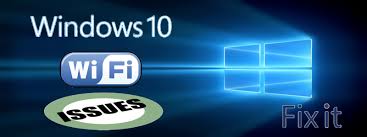Fix Wi-Fi problem: How to fix Wi-Fi, connection problem, internet speed
Slow Wi-Fi can be very annoying, especially if you are studying or working from home. Slow internet speed can ruin your day whether you need to upload work-related files to the cloud or whether you need to stream your favorite shows on Netflix. Slow Wi-Fi is a problem you can fix. In most cases, slow Wi-Fi can be fixed in a few easy steps .. Follow this guide as we list some methods to fix Wi-Fi connection problems.
Slow Wi-Fi: How to Fix
There are many factors at play that can result in slowing down Wi-Fi. These are some of the ways by which you can identify Wi-Fi connection problems.
1. Do you have slow internet speed?
Before jumping to the conclusion of slow internet speed, make sure that the advertised speed of your internet plan matches the internet speed you are getting. To do this, go to any website that allows you to measure internet speed such as speedtest.net or fast.com. If the speed results match with the advertised speed provided by your ISP (Internet service provider), then we will say that your connection is perfectly fine, and to speed things up, you can always go for an advanced plan that Provides faster internet speed.
2. Restart the Wi-Fi to fix the Wi-Fi problems
Sometimes all you need to do with your Wi-Fi router is a quick restart to fix Wi-Fi connection issues. Just turn off your Wi-Fi router and then turn it on after a few seconds and then check if you are still getting slow internet speed. If this does not fix Wi-Fi problems, try restarting your computer, phone, or other devices. Sometimes the reason for slow internet speed maybe just your device and not the internet connection.
3. Positioning of Wi-Fi routers can fix slow Wi-Fi
Are you experiencing slow internet speeds despite having a high-speed internet connection and a good Wi-Fi router? The problem may be with the state of your router. It is recommended to always place the router higher, such as above the cupboard. In addition, you can always see Wi-Fi routers at various locations in your home or workplace to see which area gets the best signal strength before finalizing a location. Note, Wi-Fi signals are usually able to pass through walls and other objects, but in some instances, thick walls or some metals disrupt the signals. In such scenarios, it is always recommended to keep your router away from the microwave oven or refrigerator, and as we mentioned above, keep the router at an elevation and an optimal location.
4. Adjust the router's antennas
The position of the antennas on the Wi-Fi router directly redirects the Wi-Fi signals in one direction. Therefore you should always point the antennas in different directions. For example, many Wi-Fi routers come with two or three antennas. In such a scenario, be sure to point the antennas in the vertical and horizontal directions, so that the Wi-Fi signal can cover a wider area.
5. Use a strong Wi-Fi security standard
If your Wi-Fi security is not strong enough, it can be easy to gain access to a password. Our neighbor may be stealing your Wi-Fi connection, and you may have slow Wi-Fi. Therefore, it is always suggested to use the WPA2 security protocol on your router. You can change this through the settings of your router. To set a WPA2 password, access your Wi-Fi settings by entering your router's IP address in any browser on your phone or computer. You can find the IP address of your router on the back of the router, or you can also search for it using the network settings of your Wi-Fi on your phone or computer.
6. Single connection, multiple users
You can have a high-speed Internet connection that is shared by many users in your home or your workplace, and when a Wi-Fi router doesn't slow down the Internet speed when many people use it, Your available bandwidth is not compromised. This means that you can download files from the cloud while your child can download that latest game from the PlayStation Network, while your partner can stream their favorite movie or TV show. In such a scenario, you can face all the slow Wi-Fi because each device is using a significant portion of the available bandwidth.
In this case, you can try to reduce the load on the Internet connection by stopping one of the streams or downloads. This can lead to better Wi-Fi speeds for others. Modern routers support technology that ensures the same bandwidth across all devices, and if you are also experiencing problems with one of those routers, the bottleneck maybe your Internet speed.
7. Using QoS to Fix Slow Wi-Fi
One of the best tools available that are often overlooked is QoS or quality of service, whose job is to radically divide the available bandwidth on your Wi-Fi network between applications. With an optimal setting, you can watch that wildlife video on YouTube in 4K resolution without a hitch, ensuring that your latest game gets downloaded to Steam. With QoS, you can decide which service to prioritize on your Wi-Fi network and therefore divide bandwidth accordingly. Note, there are different ways for a router to access QoS settings, which means that the way to access QoS on a Netgear router will be different from the TP-Link router. To check your router's QoS settings, enter your router's IP address in a browser and look for the QoS tab to access the settings.
8. Update the router's firmware to fix Wi-Fi connection problems
Software updates are very important for your router as they improve its stability, performance, and security. Most routers available these days come with the ability to update themselves automatically, although if you are doing an older router, you may have to install software updates manually. Different routers have different ways to update software. To learn more, enter the router's IP address in any browser on your phone or computer to use the Wi-Fi settings for your router.
9. Changing DNS Server
Despite their different Internet plans, each ISP uses a DNS (Domain Name System), which basically helps to translate the IP addresses of the servers to domain names such as youtube.com or facebook.com. Mostly, the default DNS server provided by an ISP is slow and unreliable, and this is why simply changing your DNS server can give you relief and provide a much-needed benefit in your Internet speed and performance. To learn how to change DNS, you can see our guide on iOS, or how to change DNS on your computer. For those using Android, go to the Wi-Fi settings on your phone and look for the Private DNS option. By default, this is turned off on most Android phones, but you can choose to set it to automatic or you can also do it by manually setting the private DNS provider hostname.
10. Use a Wi-Fi Analyzer
A Wi-Fi analyzer app can be a powerful tool in determining the best channel that is less crowded and provides minimal interference. There are two main bands used in Wi-Fi communication - 2.4GHz and 5GHz. The 5GHz band is less congested but has a shorter range, so be careful when analyzing the results of these devices. These bands are divided into several channels and this is where the Wi-Fi analyzer helps to detect that Wi-Fi networks are broadcasting on the same channels so that you can choose an alternative. Various free and paid Wi-Fi analyzer apps are available on the Internet which can help you in solving such issues. You can check out some of the popular Wi-Fi analyzer options for phones and computers such as NetSpot, Insider, NetX, and Network Performance Monitor to name a few.
11. Change Your Wi-Fi Channel
If you find the IP address of your router and it is used to access your Wi-Fi settings in any browser, then you will come to the channels under Wireless Settings. There are 14 channels in total and first, you have to find out which Wi-Fi channel is most preferred in your area. Once you determine this, you can always try to find and select a non-overlapping channel that extends far beyond the other channels. Most channels in the ISP set the settings automatically, but if you are getting slow internet speed, we would say that you should fade around and find the clearest channel for the best optimal experience for you Put it.
12. Reset your device's network settings
If resetting your Wi-Fi router does not solve your problem, then you should probably consider resetting your device's network settings. By resetting your device's network settings, you'll basically set them to default. From there, you can reconfigure your Wi-Fi on all your devices and check if it solved your problem. The steps are different for each device and you will have to re-enter your Wi-Fi password to access the Internet. If you have forgotten it, you can check our handy guide to find your Wi-Fi password.
13. Buy a new Wi-Fi router
Getting a high-speed internet plan does not solve the quest of achieving high internet speed, but your Wi-Fi router also has a big role. You see, you can get a high-speed Internet plan, but if your Wi-Fi router is outdated or doesn't comply with the new Wi-Fi standards, you can't get the most out of it. To fix this problem, try to get a new Wi-Fi router that is 802.11ac (known as Wi-Fi 5) or at least 802.11n (also known as Wi-Fi 4) ) Supports. However, if you are looking for a superfast Wi-Fi router, you can also buy one that supports the latest 802.11ax standards (known as Wi-Fi 6). Although keep in mind that since this technology is still under development, routers supporting Wi-Fi 6 standards are actually very expensive.
14. File a Complaint with your ISP
If none of the methods described above work for you, you should probably contact your ISP and let the professionals take notice of the problem. Sometimes it is better to call and file a complaint rather than just trying to fix things on your own, and if your ISP has a good track record with customer service, your problem can be fixed in a minimum time is.
15. Change Your ISP
If your current ISP is not able to meet your needs in your area and you are still working at a slow Internet speed, then your last resort will be to find and change a better connection. In such a scenario, it is always better to do some research and find out which connection provides the best price-to-performance ratio in your area. It is also good to talk with your neighbors and see what connection they are using and how well it is serving them.








0 Comments